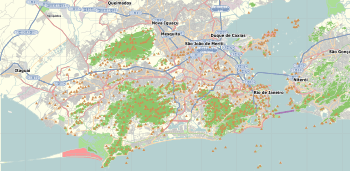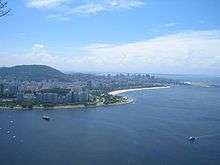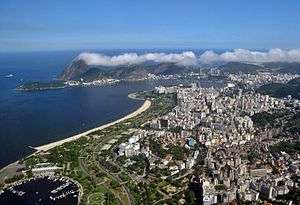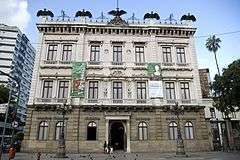Flamengo, Rio de Janeiro
Flamengo is a neighborhood in Rio de Janeiro, Brazil.
Flamengo | |
|---|---|
Neighborhood | |
 Flamengo Location in Rio de Janeiro  Flamengo Flamengo (Brazil) | |
| Coordinates: 22°56′01″S 43°10′28″W | |
| Country | |
| State | Rio de Janeiro (RJ) |
| Municipality/City | Rio de Janeiro |
| Zone | South Zone |


History
It is the Portuguese word for Flemish, and it was given to the nearby beach (Praia do Flamengo, Beach of the Flemish) because it was the place where the Dutch sailor Olivier van Noort tried to invade the city in 1599. At that time, the Dutchmen were called "Flemish" by the Portuguese.[1]
Characteristics
It is located between Catete and Botafogo districts on the edge of Guanabara Bay. The beachfront area is dominated by the Brigadier Eduardo Gomes Park, also known as Aterro do Flamengo, built by Lota de Macedo Soares on nearly 300 acres (1.2 km²) of land reclaimed from the bay and completed in 1965. The park features gardens designed by well-known Brazilian landscape designer Roberto Burle Marx.
The district and surroundings are serviced by three subway stations: Flamengo, Largo do Machado and Catete, and many bus lines that link it to the rest of the city. It is fairly close to the city centre and offers excellent views of Pão de Açúcar (Sugarloaf Mountain) and the statue of Christ the Redeemer. Nowadays, it is mostly a middle-class residential neighborhood.
Its main streets are Senador Vergueiro, Marquês de Abrante and Praia do Flamengo.
Destinations
- Carmen Miranda Museum
- Flamengo Park—Parque Brigadeiro Eduardo Gomes
- Marina da Glória
- Monument to the Dead of World War II
- Museum of Modern Art, Rio de Janeiro
Notable residents
- Zózimo Bulbul, actor and filmmaker[2]
References
- GARCIA, S. Rio de Janeiro: Passado e Presente. Rio de Janeiro: Conexão Cultural, 2000. p. 37
- "Morre o ator e cineasta Zózimo Bulbul, aos 75 anos". O Globo. 2013-01-24. Retrieved 2013-02-03.
